Numerical Modeling of Surface Water and Groundwater Interactions Induced by Complex Fluvial Landforms and Human Activities in the Pingtung Plain Groundwater Basin, Taiwan
Abstract
1. Introduction
2. Materials and Methods
2.1. Study Area
2.2. Modeling Framework
3. Conceptual Models and Numerical Considerations
3.1. Conceptual Model and Parameters for Groundwater Flow
3.2. Conceptual Model and Parameters for Surface Water Flow
4. Results and Discussion
4.1. Model Calibration and Validation
4.2. Surface Water and Groundwater Interactions
4.2.1. Water Cycle for the Entire PPGB
4.2.2. Seasonal Variations of the SGIs and Interactions Near the Soil Zones
4.2.3. The Behavior of the Interactions in the Upstream and Downstream Fans
4.2.4. Effects of the Artificial Recharge on the Local Water Cycle
5. Conclusions
Author Contributions
Funding
Acknowledgments
Conflicts of Interest
References
- Yang, Z.; Zhou, Y.; Wenninger, J.; Uhlenbrook, S.; Wang, X.; Wan, L. Groundwater and surface-water interactions and impacts of human activities in the Hailiutu catchment, northwest China. Hydrogeology 2017, 25, 1341–1355. [Google Scholar] [CrossRef]
- Lekula, M.; Lubczynski, M.W. Use of remote sensing and long-term in-situ time-series data in an integrated hydrological model of the Central Kalahari Basin, Southern Africa. Hydrogeology 2019, 27, 1541–1562. [Google Scholar] [CrossRef]
- An, H.; Yu, S. Finite volume integrated surface-subsurface flow modeling on non-orthogonal grids. Water Resour. Res. 2014, 50, 2312–2328. [Google Scholar] [CrossRef]
- Wei, X.; Bailey, R.T. Assessment of system responses in intensively irrigated stream-aquifer systems using SWAT-MODFLOW. Water 2019, 11, 1576. [Google Scholar] [CrossRef]
- Kuffour, B.N.; Engdahl, N.; Woodward, C.; Condon, L.; Kollet, S.; Maxwell, R. Simulating coupled surface-subsurface flows with ParFlow v3.5.0: Capabilities, applications, and ongoing development of an open-source, massively parallel, integrated hydrologic model. Geosci. Model Dev. 2020, 13, 1373–1397. [Google Scholar] [CrossRef]
- Panday, S.; Huyakorn, P.S. A fully coupled physically-based spatially-distributed model for evaluating surface/subsurface flow. Adv. Water Resour. 2004, 27, 361–382. [Google Scholar] [CrossRef]
- Muma, M.; Rousseau, A.N.; Gumiere, S.J. Assessment of the impact of subsurface agricultural drainage on soil water storage and flows of a small watershed. Water 2016, 8, 326. [Google Scholar] [CrossRef]
- Brunner, P.; Simmons, C.T. HydroGeoSphere: A fully integrated, physically based hydrological model. Ground Water 2012, 50, 170–176. [Google Scholar] [CrossRef]
- Salem, A.; Dezső, J.; El-Rawy, M.; Lóczy, D. Hydrological modeling to assess the efficiency of groundwater replenishment through natural reservoirs in the Hungarian Drava River floodplain. Water 2020, 12, 250. [Google Scholar] [CrossRef]
- El-Rawy, M.; Zlotnik, V.A.; Al-Raggad, M.; Al-Maktoumi, A.; Kacimov, A.; Abdalla, O. Conjunctive use of groundwater and surface water resources with aquifer recharge by treated wastewater: Evaluation of management scenarios in the Zarqa River Basin, Jordan. Environ. Earth Sci. 2016, 75, 1146. [Google Scholar] [CrossRef]
- Markstrom, S.L.; Niswonger, R.G.; Regan, R.S.; Prudic, D.E.; Barlow, P.M. GSFLOW Coupled Groundwater and Surface-Water Flow Model Based on the Integration of the Precipitation Runoff Modeling System (PRMS) and the Modular Groundwater Flow Model (MODFLOW-2005); U.S. Geological Survey Techniques and Methods 6-D1; U.S. Geological Survey: Reston, VA, USA, 2008; p. 240. Available online: https://pubs.usgs.gov/tm/tm6d1/pdf/tm6d1.pdf (accessed on 13 October 2020).
- Shu, Y.; Li, H.; Lei, Y. Modelling groundwater flow with MIKE SHE using conventional climate data and satellite data as model forcing in Haihe Plain, China. Water 2018, 10, 1295. [Google Scholar] [CrossRef]
- Arnold, J.G.; Kiniry, J.R.; Srinivasan, R.; Williams, J.R.; Haney, E.B.; Neitsch, S.L. Soil and Water Assessment Tool Input/Output File Documentation Version 2009; Texas Water Resources Institute Technical Report No. 365; Texas A&M University System: College Station, TX, USA, 2011; Available online: https://swat.tamu.edu/media/19754/swat-io-2009.pdf (accessed on 13 October 2020).
- Harbaugh, A.W. MODFLOW-2005, The U.S. Geological Survey Modular Groundwater Model—The Groundwater Flow Process; USGS Techniques and Methods 6-A16; USGS: Reston, VA, USA, 2005. Available online: https://doi.org/10.3133/tm6A16 (accessed on 13 October 2020).
- Leavesley, G.H.; Lichty, R.W.; Troutman, B.M.; Saindon, L.G. Precipitation Runoff Modeling System; User’s Manual; USGS Water Resources Investigations Report 83-4238; USGS: Denver, CO, USA, 1983. Available online: https://doi.org/10.3133/wri834238 (accessed on 13 October 2020).
- McCallum, A.M.; Andersen, M.S.; Giambastiani, B.M.S.; Kelly, B.F.J.; Ian Acworth, R. River aquifer interactions in a semi-arid environment stressed by groundwater abstraction. Hydrol. Process. 2013, 27, 1072–1085. [Google Scholar] [CrossRef]
- Wu, B.; Zheng, Y.; Wu, X.; Tian, Y.; Han, F.; Liu, J.; Zheng, C. Optimizing water resources management in large river basins with integrated surface water-groundwater modeling: A surrogate-based approach. Water Resour. Res. 2015, 51, 2153–2173. [Google Scholar] [CrossRef]
- Joo, J.; Tian, Y.; Zheng, C.; Zheng, Y.; Sun, Z.; Zhang, A.; Chang, H. An integrated modeling approach to study the surface water-groundwater interactions and influence of temporal damping effects on the hydrological cycle in the Miho catchment in South Korea. Water 2018, 10, 1529. [Google Scholar] [CrossRef]
- Suppe, J. Kinematics of arc-continental collision, flipping of subduction, and back-arc spreading near Taiwan. Mem. Geol. Soc. China 1984, 6, 21–33. [Google Scholar]
- Vu, T.D.; Ni, C.F.; Li, W.C.; Truong, M.H. Modified index-overlay method to assess spatial-temporal variations of groundwater vulnerability and groundwater contamination risk in areas with variable activities of agriculture developments. Water 2019, 11, 2492. [Google Scholar] [CrossRef]
- Ting, C.S.; Zhou, Y.X.; De Vries, J.J.; Simmers, I. Development of a preliminary groundwater flow model for water resources management in the Pingtung Plain, Taiwan. Ground Water 1997, 36, 20–36. [Google Scholar] [CrossRef]
- Taiwan, C.G.S. Hydrogeological Survey Report of Pingtung Plain, Taiwan; Central Geological Survey Ministry of Economic Affairs Executive Yuan: Taiwan, 2002; pp. 97–142.
- Leavesley, G.H.; Restrepo, P.J.; Markstrom, S.L.; Dixon, M.; Stannard, L.G. The Modular Modeling System (MMS): User’s Manual; U.S. Geological Survey Open-File Report 96-151; U.S. Geological Survey: Denver, CO, USA, 1996. Available online: https://pubs.usgs.gov/of/1996/0151/report.pdf (accessed on 13 October 2020).
- Niswonger, R.G.; Prudic, D.E.; Regan, R.S. Documentation of the Unsaturated-Zone Flow (UZF1) Package for Modeling Unsaturated Flow between the Land Surface and the Water Table with MODFLOW-2005; U.S. Geological Survey Techniques and Methods 6-A19; U.S. Geological Survey: Reston, VA, USA, 2006; p. 74. Available online: https://pubs.usgs.gov/tm/2006/tm6a19/pdf/tm6a19.pdf (accessed on 13 October 2020).
- Brooks, R.H.; Corey, A.T. Properties of porous media affecting fluid flow. Irrig. Drain. Div. 1966, 92, 61–88. [Google Scholar]
- Liang, C.P.; Jang, C.S.; Liang, C.W.; Chen, J.S. Groundwater vulnerability assessment of the Pingtung plain in Southern Taiwan. Int. J. Environ. Res. Public Health 2016, 13, 1167. [Google Scholar] [CrossRef] [PubMed]
Publisher’s Note: MDPI stays neutral with regard to jurisdictional claims in published maps and institutional affiliations. |

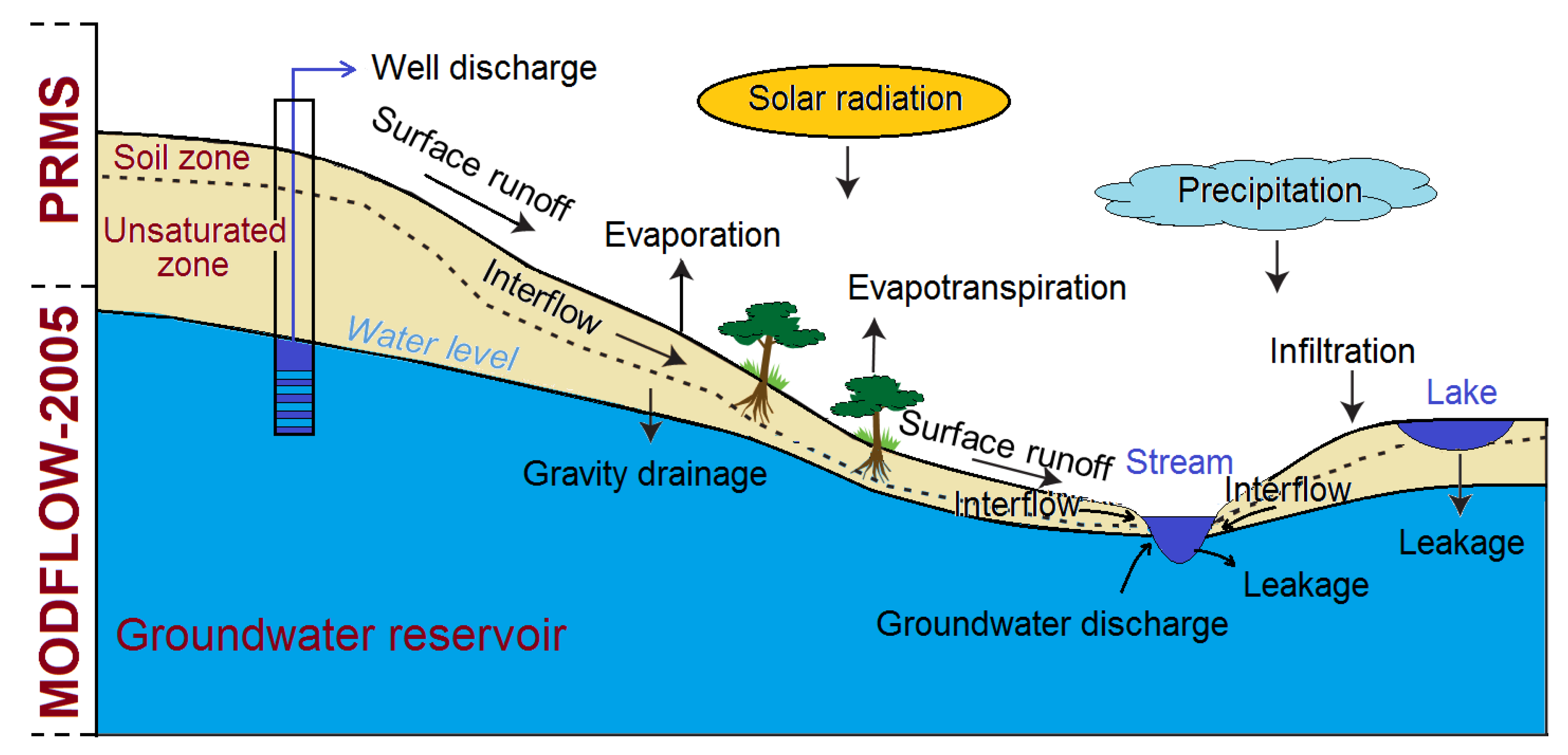
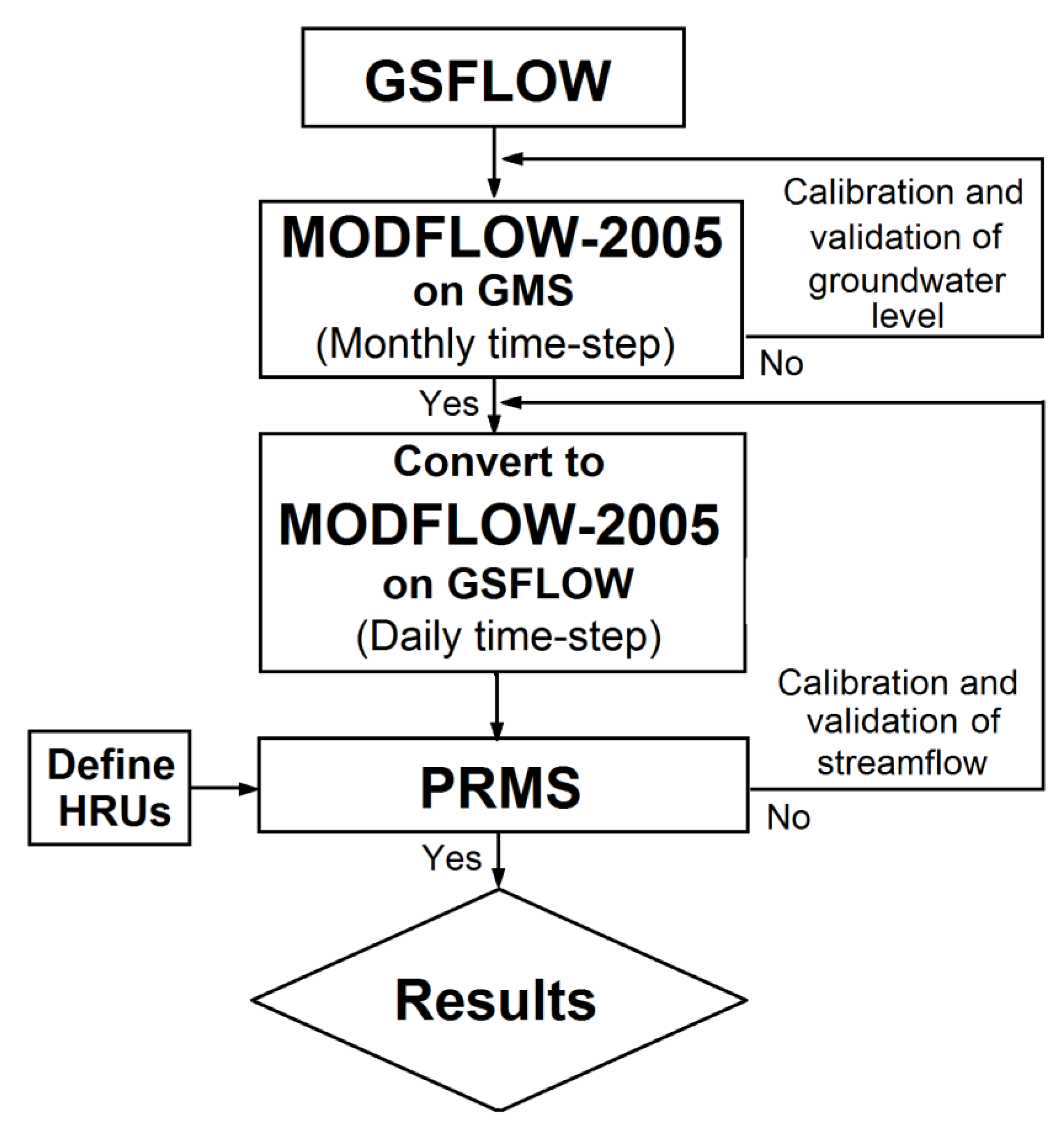
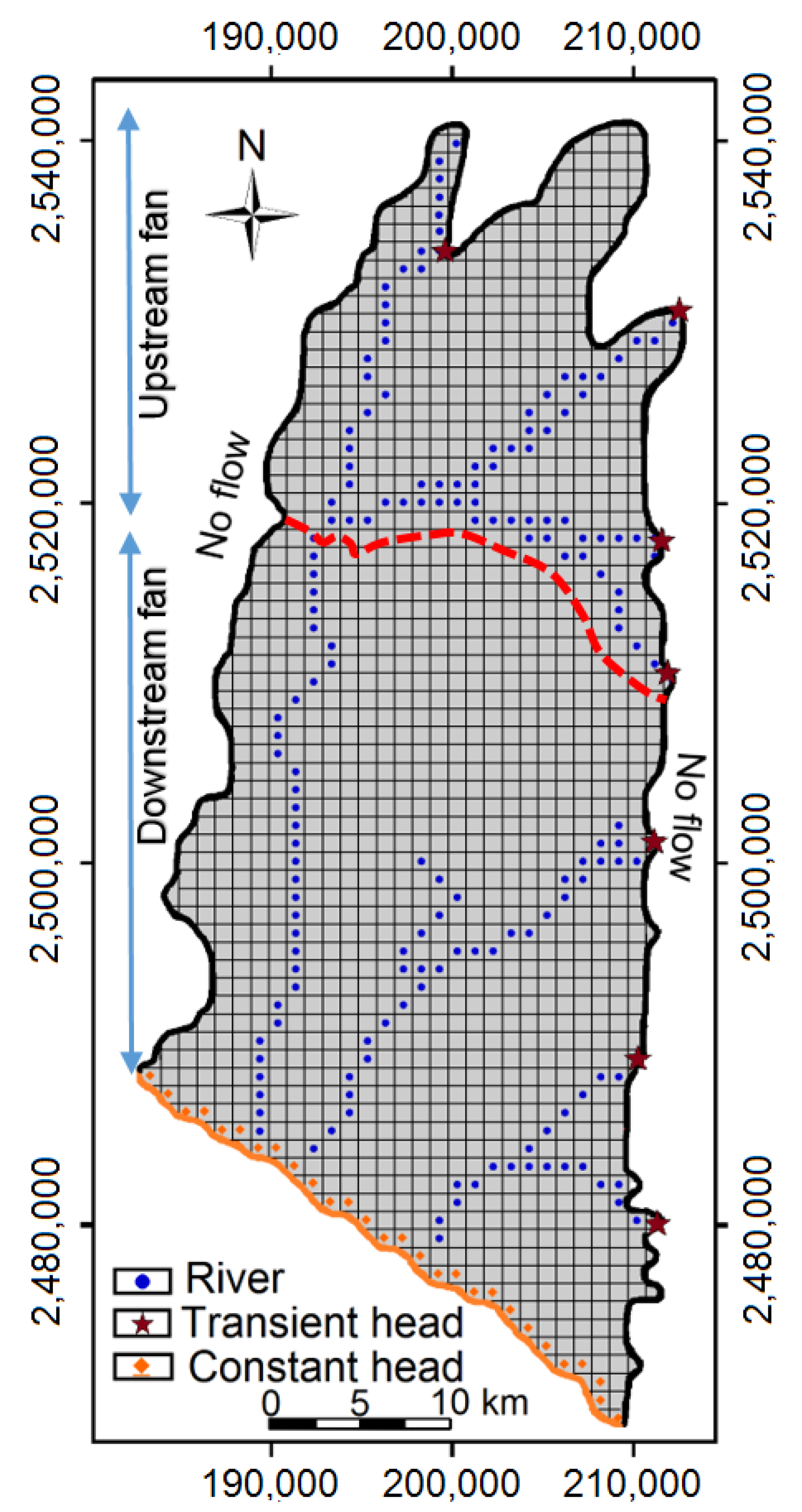
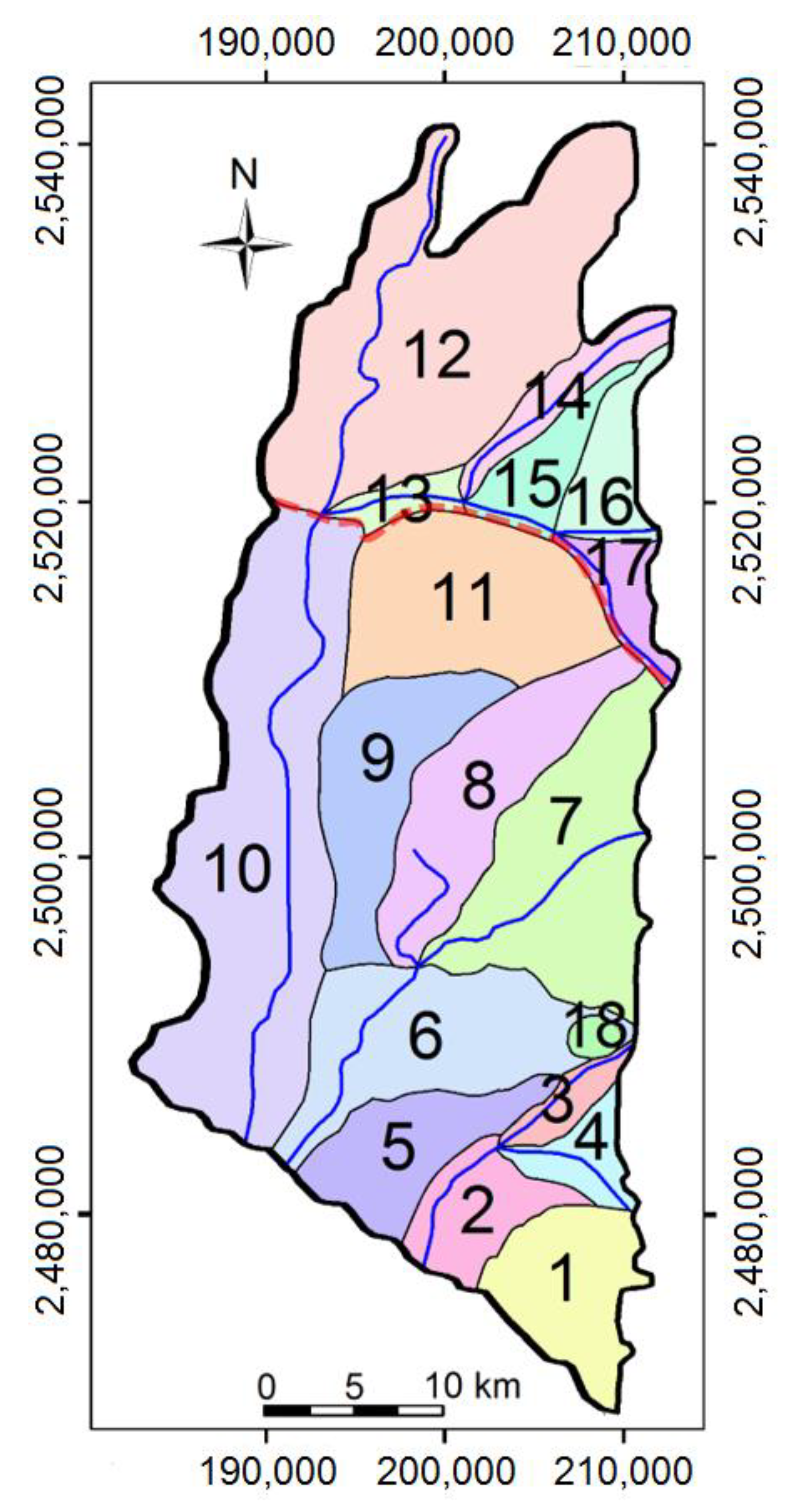
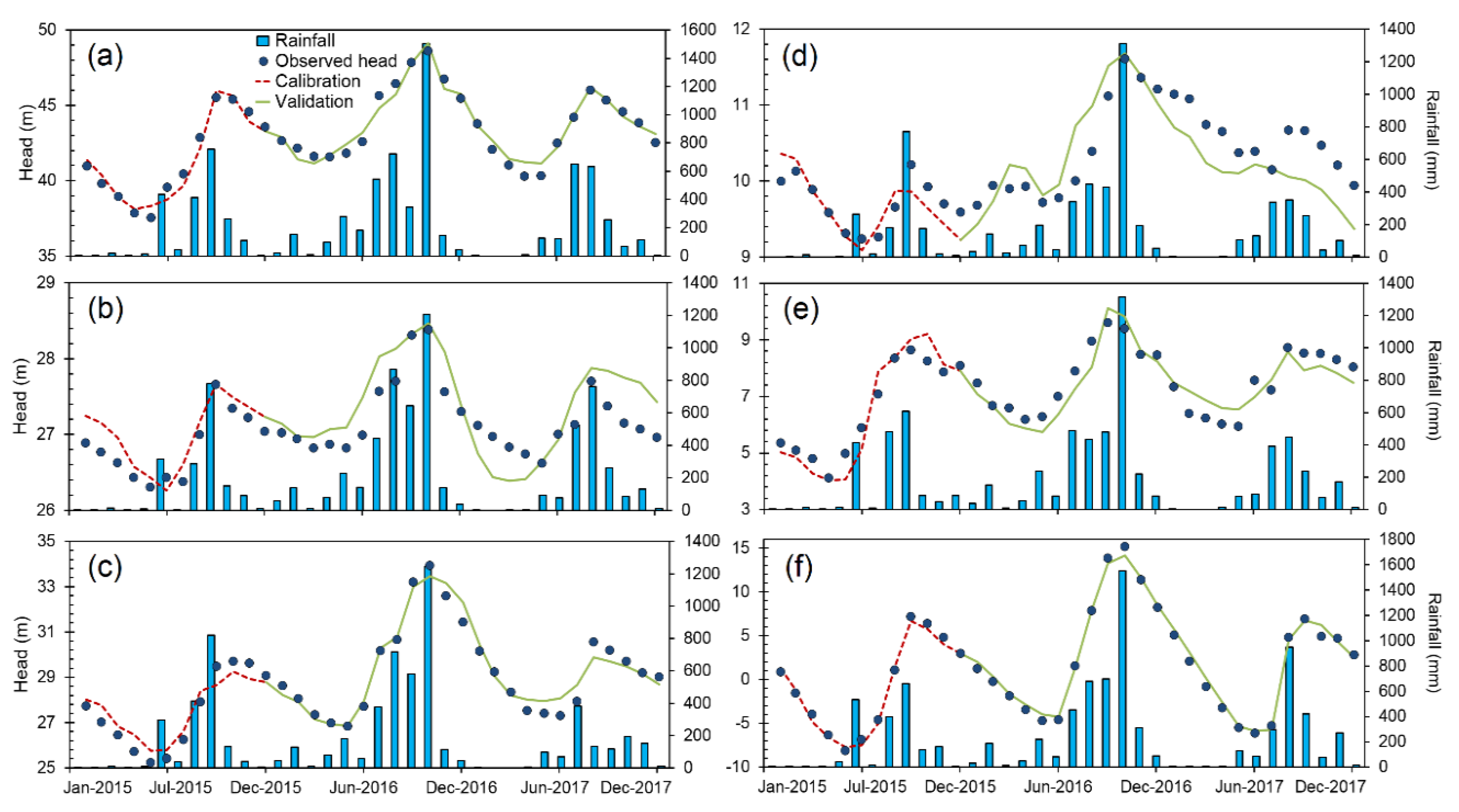
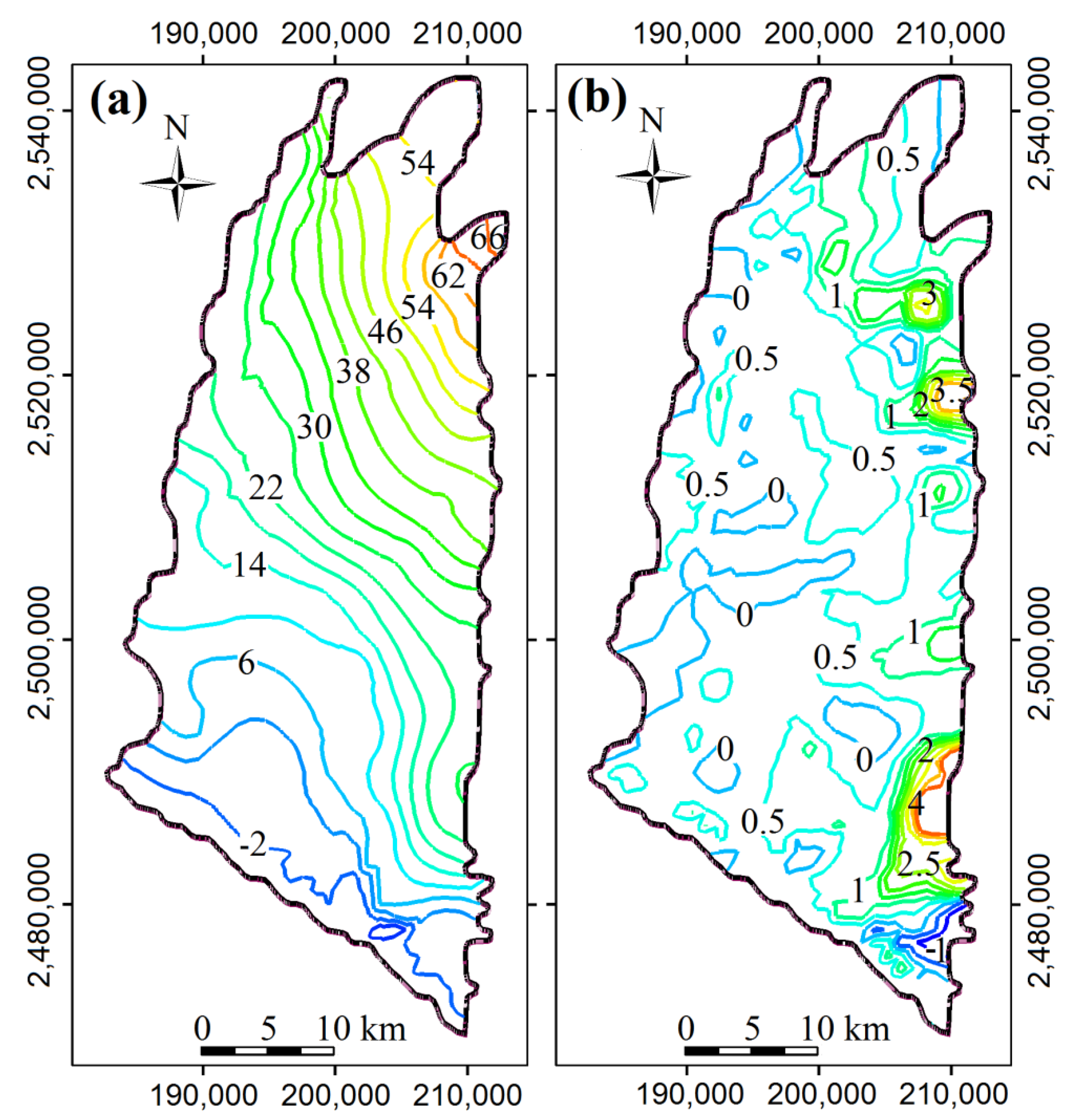

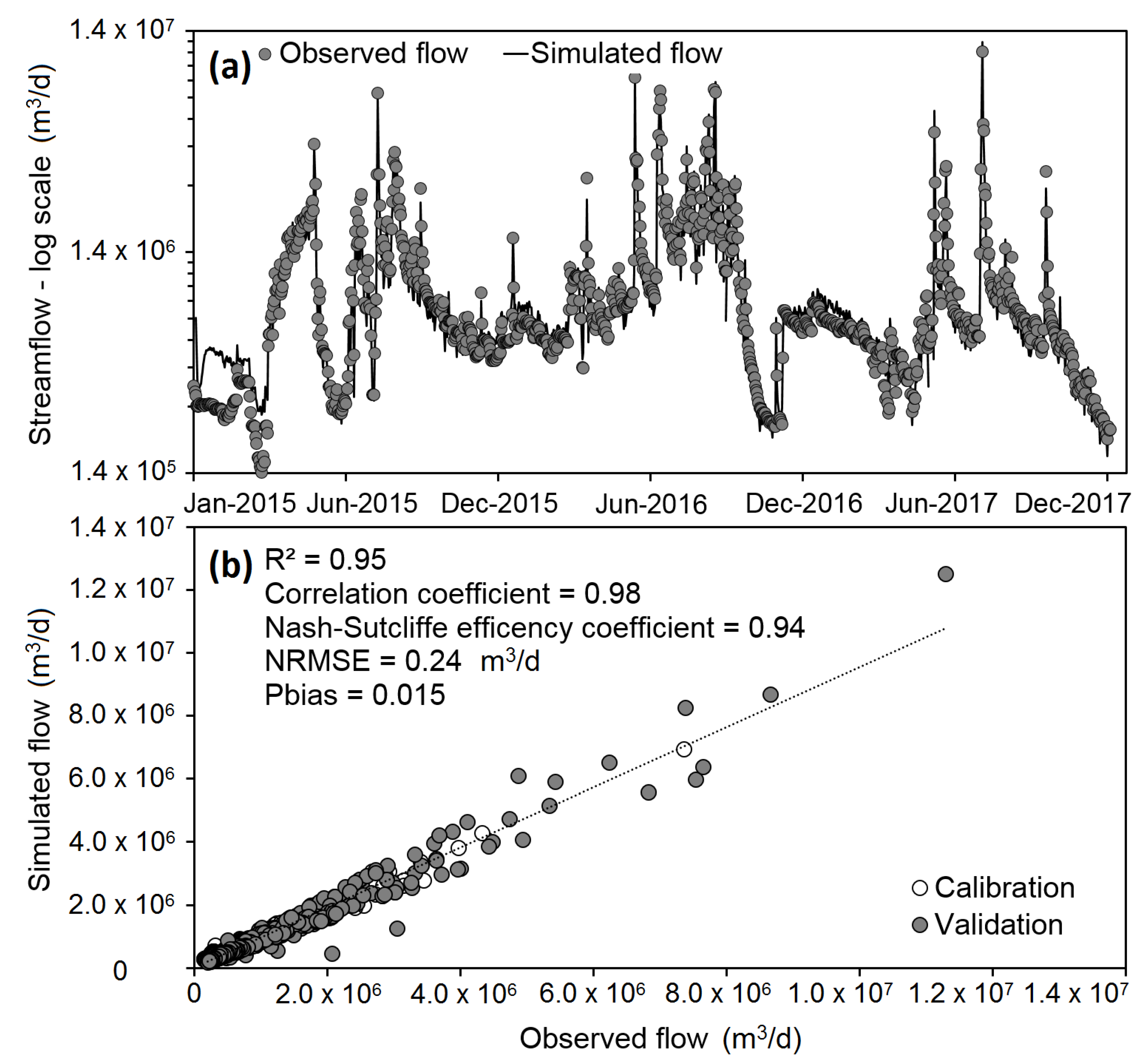
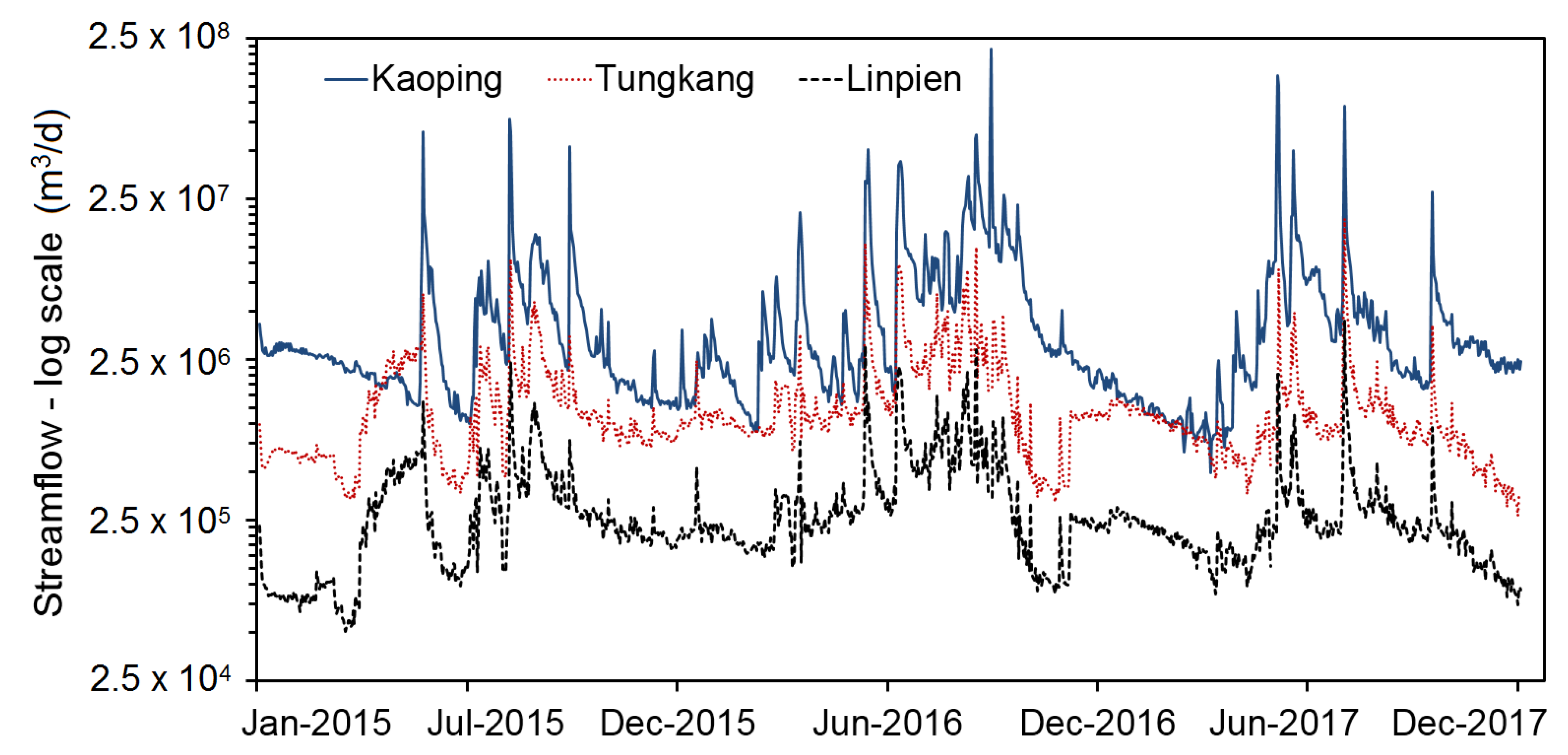
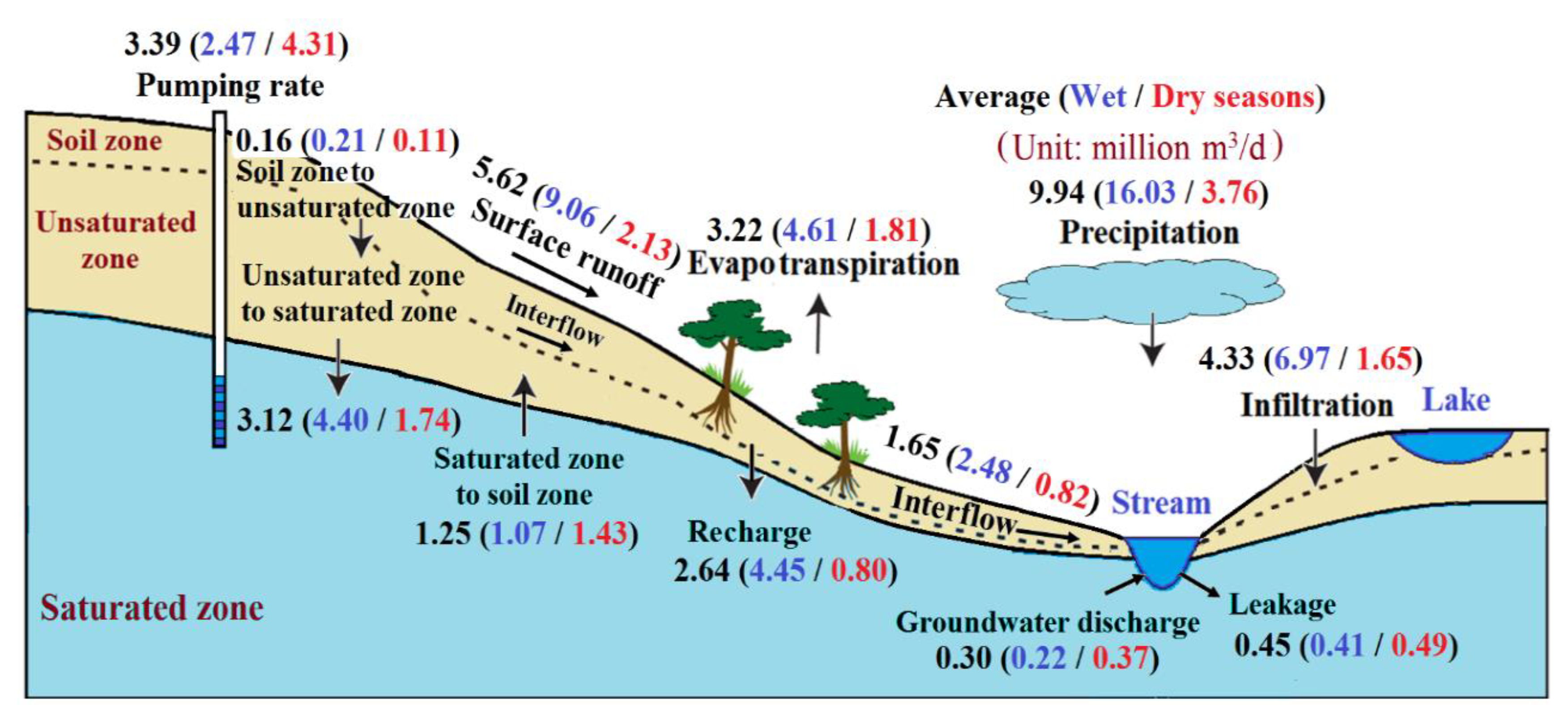
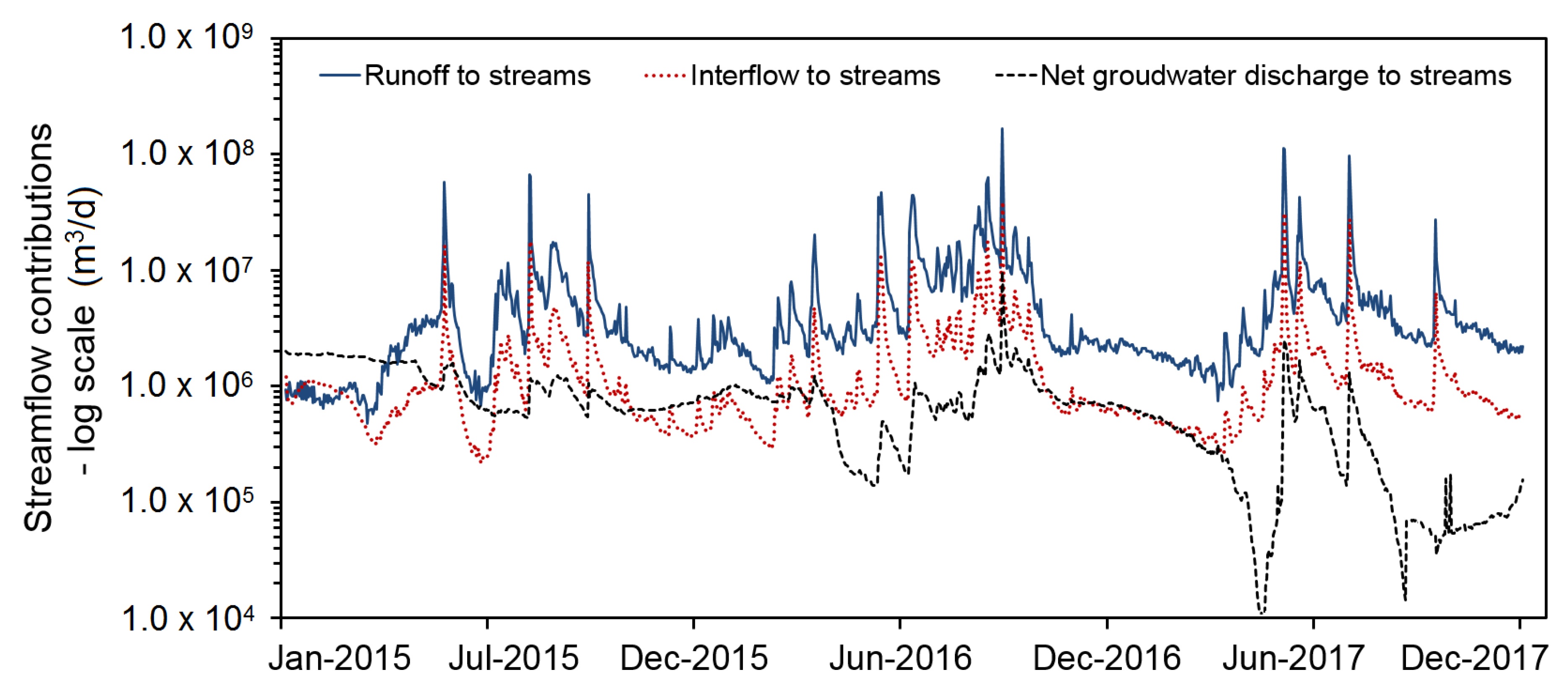
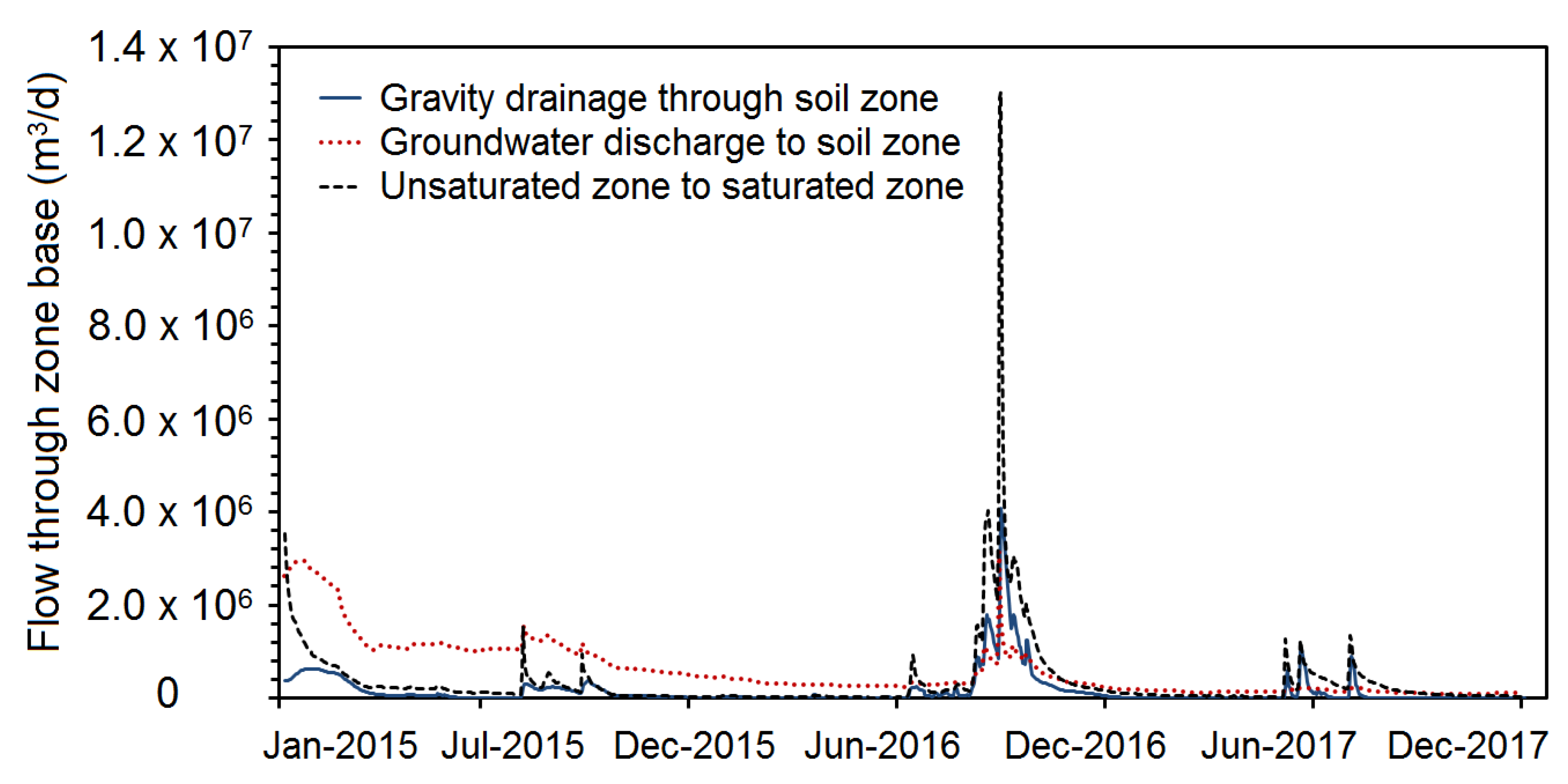
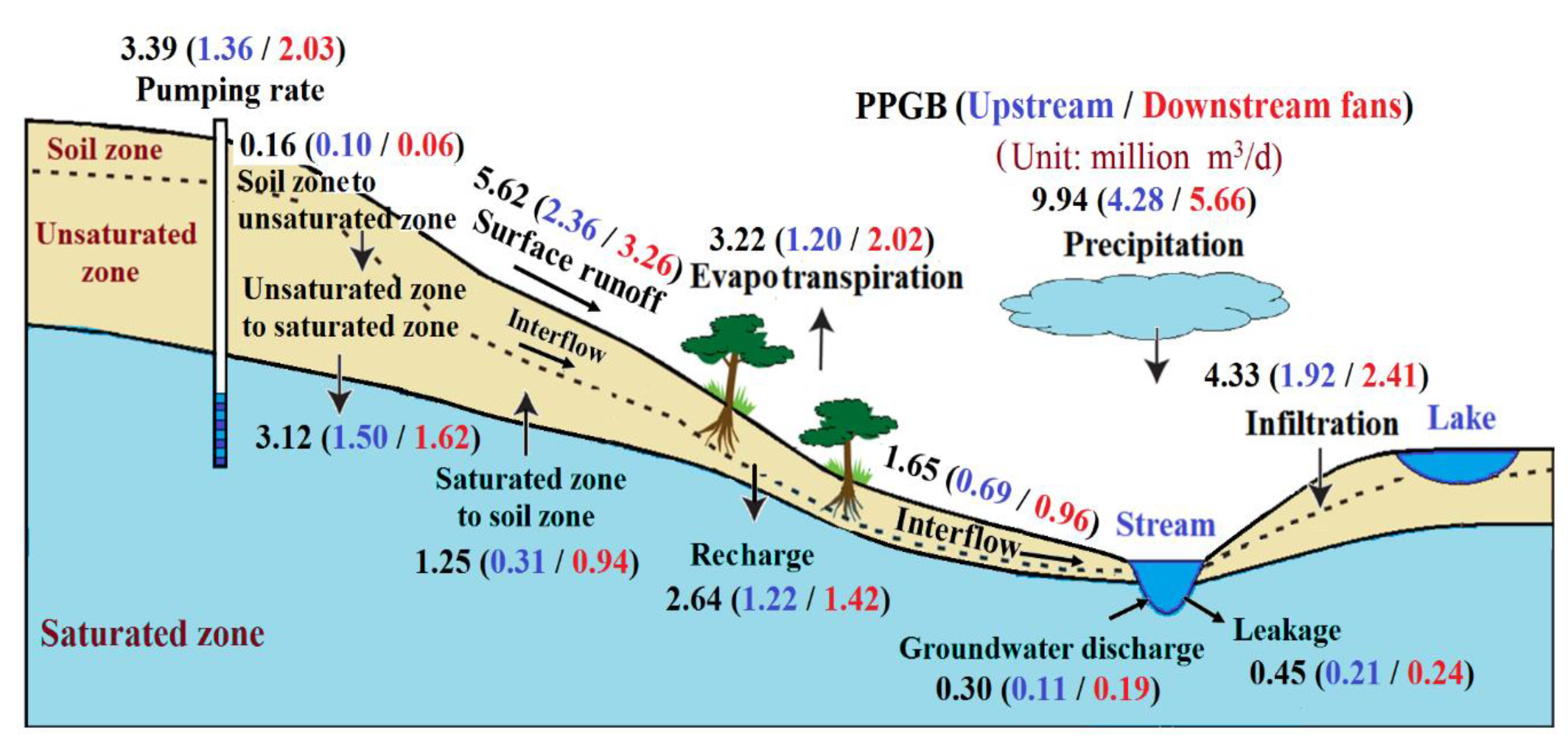
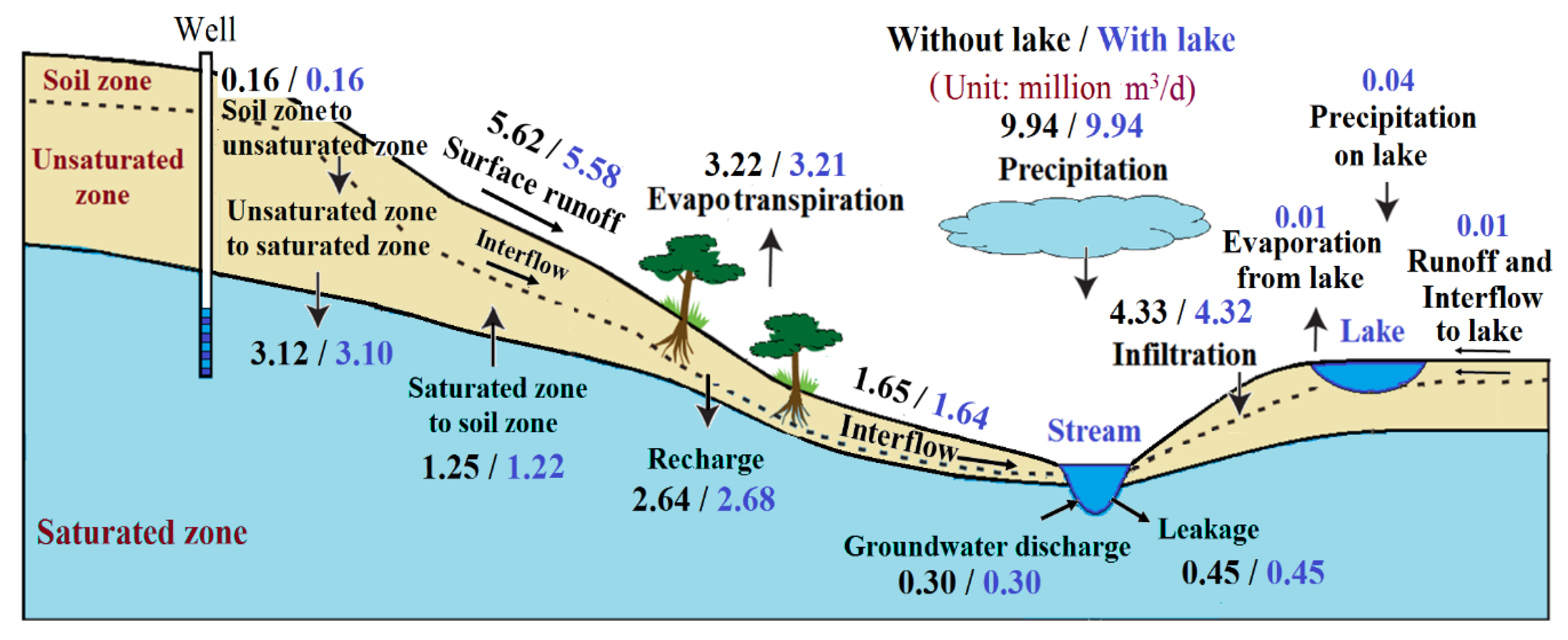
| Parameter | Minimum Value | Maximum Value |
|---|---|---|
| fastcoef_lin | 0.4 | 0.4 |
| jh_coef | 0.0024 | 0.004 |
| pref_flow_den | 0.4 | 0.4 |
| smidx_coef | 0.03 | 0.03 |
| soil_moist_max | 12 | 12 |
| soil_rechr_max | 6 | 6 |
| ssr2gw_exp | 0.5 | 0.5 |
| ssr2gw_rate | 0.2 | 0.2 |
| wrain_intcp | 0.05 | 0.05 |
| smidx_exp | 0.6 | 0.6 |
| soil2gw_max | 5 | 5 |
| ssstor_init | 10 | 10 |
| rain_adj | 1.76 | 5 |
| Sources/Sinks | In (m3/d) | Out (m3/d) | STDin (m3/d) | STDout (m3/d) |
|---|---|---|---|---|
| Storage | 3.96 × 106 | 2.00 × 105 | 1.86 × 106 | 2.19 × 105 |
| Constant head | 1.12 × 105 | 1.74 × 105 | 9.68 × 104 | 2.09 × 105 |
| Wells | 0 | 3.43 × 106 | 0 | 1.38 × 106 |
| UZF recharge | 2.13 × 105 | 0 | 2.88 × 105 | 0 |
| GW Evapotranspiration | 0 | 2.32 × 104 | 0 | 3.42 × 104 |
| Surface leakage | 0 | 5.44 × 105 | 0 | 6.30 × 105 |
| Stream leakage | 3.53 × 105 | 2.75 × 105 | 1.19 × 105 | 3.61 × 105 |
| Total | 4.64 × 106 | 4.64 × 106 | 1.79 × 106 | 1.79 × 106 |
| In-Out | −8.77 × 102 | |||
| Percent Discrepancy | −1.97 × 10−2 | |||
© 2020 by the authors. Licensee MDPI, Basel, Switzerland. This article is an open access article distributed under the terms and conditions of the Creative Commons Attribution (CC BY) license (http://creativecommons.org/licenses/by/4.0/).
Share and Cite
Tran, Q.-D.; Ni, C.-F.; Lee, I.-H.; Truong, M.-H.; Liu, C.-J. Numerical Modeling of Surface Water and Groundwater Interactions Induced by Complex Fluvial Landforms and Human Activities in the Pingtung Plain Groundwater Basin, Taiwan. Appl. Sci. 2020, 10, 7152. https://doi.org/10.3390/app10207152
Tran Q-D, Ni C-F, Lee I-H, Truong M-H, Liu C-J. Numerical Modeling of Surface Water and Groundwater Interactions Induced by Complex Fluvial Landforms and Human Activities in the Pingtung Plain Groundwater Basin, Taiwan. Applied Sciences. 2020; 10(20):7152. https://doi.org/10.3390/app10207152
Chicago/Turabian StyleTran, Quoc-Dung, Chuen-Fa Ni, I-Hsien Lee, Minh-Hoang Truong, and Chien-Jung Liu. 2020. "Numerical Modeling of Surface Water and Groundwater Interactions Induced by Complex Fluvial Landforms and Human Activities in the Pingtung Plain Groundwater Basin, Taiwan" Applied Sciences 10, no. 20: 7152. https://doi.org/10.3390/app10207152
APA StyleTran, Q.-D., Ni, C.-F., Lee, I.-H., Truong, M.-H., & Liu, C.-J. (2020). Numerical Modeling of Surface Water and Groundwater Interactions Induced by Complex Fluvial Landforms and Human Activities in the Pingtung Plain Groundwater Basin, Taiwan. Applied Sciences, 10(20), 7152. https://doi.org/10.3390/app10207152






